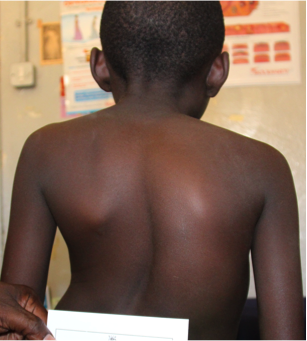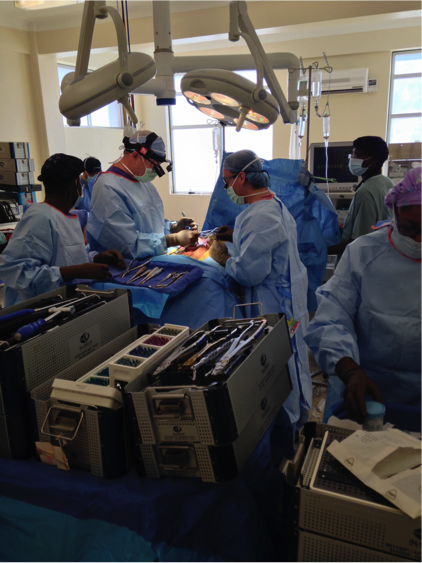My head felt like it just hit the pillow when the alarm rang at 6AM this morning. After almost making the intestinally devastating mistake of brushing my teeth with tap water, I showered using the broken hand held shower and ambled downstairs. Today was another big day for the spine team and it started off with our now standard breakfast at the hotel – pale scrambled eggs, sausage, sweet bread, potatoes, coffee, and some of the most delicious pineapple I've ever had. Washed all down with Ugandan coffee and a desert of Malerone anitmalarial medication. We headed into the hospital planning to do one "smaller" case first followed by a multilevel scoliosis case. As soon as we hit the OR at 7:30, we had to go into immediate trouble shooting mode.
Our cases had been switched without our knowledge and the scoliosis case was going first. The instruments we required for both cases had not been autoclaved to sterilize them because the power was down and the OR autoclave machine would not work. To top it off we didn't have an electrocautery pad (essential to reduce blood loss). These obstacles aren't even considerations in the States but fortunately we had Brian and Sherron on the team. These two set the standard for team work. While they got to work, Dr. St Clair and I (Eric) began rounds and got a chance to see Eziekel sitting up in bed smiling. He was doing great, a bed over from him was Mary who was quiet but wanly smiled with those trusting eyes. Brian somehow found an autoclave in another building and managed to get the job done. Sherron worked her magic and located another bovie pad, hooked it up, and after a brief delay we were ready to go. Our first case was Shakira, a little 10 year old girl with progressive juvenile idiopathic scoliosis who was brought in by her concerned father from an outlying village.
Dr. St Clair sent me over to help Dr. Kip position the child and obtain the surgical exposure. As I have moved through this task, Drs. Kip and St Clair have helped me continually advance my surgical skill set. Today Dr. Kip and I each exposed a side of the spine and I identified the relative anatomy key for placing instrumentation. Dr. St Clair joined us and we efficiently moved through the case. Throughout the case we had Mbarara nursing and medical students come to observe and it was Sherron's hawk-like eyes that protected the equipment from being contaminated and kept the patient safe by reminding them to pull their surgical masks over their noses. We placed our pedicle screws (screws that hold the rods we used to correct the deformity), performed ponte osteomties (technique to remove part of the "back" of spine in order to mobilize it for correction), and then corrected the deformity maneuvering the rods to "straighten" the spine. That's a one-sentence summation of an incredibly detailed operation. There are numerous technical pearls I gleaned from each case, but in a more general sense I appreciated Drs. St Clair and Kip's mastery of the anatomy and how they used subtle variations to direct each step of the operation. We completed the case and were gratified to see the child move all of her limbs.
Under Sherron's guidance we helped sterilize the room and got our next patient, Gardenisia, into the room. Gardenisia is a 60 year old local villager who unfortunately has a cancer of unknown origin with a tumor that was compressing her spinal cord. Starting at about 9:15PM we were able to debulk her tumor, decompress her nerves, and place instrumentation to stabilize the spine. We finished, cleaned up the room and headed back to the hotel for another midnight meal. We ate in a haze of exhaustion but with a deep feeling of satisfaction. Throughout the day the concept of teamwork, which has defined this mission, seemed to be in continuous display. Not just among the members of Spine mission Uganda team, but the hospital staff in general.
Under Sherron's guidance we helped sterilize the room and got our next patient, Gardenisia, into the room. Gardenisia is a 60 year old local villager who unfortunately has a cancer of unknown origin with a tumor that was compressing her spinal cord. Starting at about 9:15PM we were able to debulk her tumor, decompress her nerves, and place instrumentation to stabilize the spine. We finished, cleaned up the room and headed back to the hotel for another midnight meal. We ate in a haze of exhaustion but with a deep feeling of satisfaction. Throughout the day the concept of teamwork, which has defined this mission, seemed to be in continuous display. Not just among the members of Spine mission Uganda team, but the hospital staff in general.
Andrew and Emmanuel the anesthesiologists willingly stayed late and ensured every patient moved through the OR to ICU with the care each one deserved. Sister Rose, the nurse manager of the OR was essential to orchestrating each case and was essential in Brian's epic quest to find the autoclave. Florence, one the OR cleaners, who had no reason to go above and beyond her job duties, tirelessly worked with us and ensured all of equipment was available. And Marvin our resident surgeon / goat herder extraordinaire who made sure all of orders made it to the right place and somehow tracked our patients down in remote villages were all essential to our success. Both the Ugandan and American teams learned how to function as a unit and this bedrock was essential to our patient's outcomes.
Quote of the day: “Mbarara at night reminds me of San Francisco.” – an exhausted Eric gazing at the town’s hillside lights at night.
Quote of the day: “Mbarara at night reminds me of San Francisco.” – an exhausted Eric gazing at the town’s hillside lights at night.



 RSS Feed
RSS Feed
